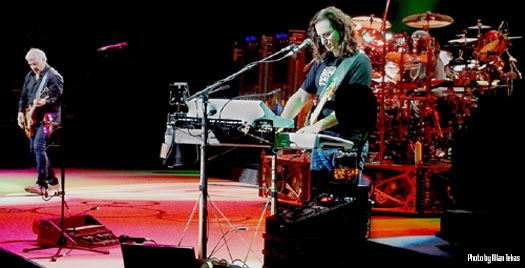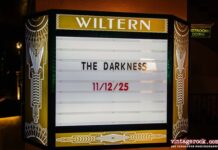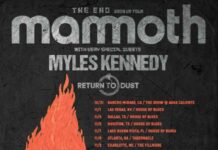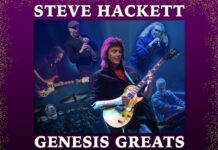Review by Shawn Perry
Photos by Ron Lyon
with additional photos by Allan Tellias
Without a “new” studio album to promote, some musical artists have to get wildly creative when they hit the road. Along with pumping out their greatest hits (which, with or without a new album, they’re going to do anyway), there are several gimmicks that can be worked in.
The all-acoustic show is a reliable standby, especially in situations where space is at a premium and volume has taken its toll. Playing with orchestras is another popular way to embellish classic songs. Then, of course, there’s playing an entire album live. Back in the 70s, the Who, Pink Floyd, Genesis, and Yes regularly played a whole platter worth of music, mostly of the conceptual variety. The trend has gained ground in more recent years, regardless of the record’s context.
This year alone, you have Roger Daltrey doing Tommy, Steely Dan doing Aja, Peter Frampton doing Frampton Comes Alive (now there’s a twist — he’s actually recreating a live album). But then you have to stand back and see what Rush has been doing since 2010. Shaking up a set list in a so-called “Time Machine,” the Canadian trio go long with a complete run through of Moving Pictures — which, coincidentally, was reissued (finally) in April 2011 in glorious 5.1 on DVD and Blu-ray.

On the first night of the band’s two-night stand at the Gibson Amphitheatre, Rush heads were out in force, comparing notes, slurping $13 imports and tuning up for their favorite band. They are a loyal bunch, mostly male, mostly over 40. Which isn’t to say Rush doesn’t have female fans (in one video sequence shown at the end of the performance, drummer Neil Peart says he saw at least seven females in the audience) — they most certainly do. While not as big in numbers, the girls are nevertheless as fervent and passionate in their love for Rush.
The stage’s art deco approach to a literal time machine, complete with old-fashioned replications of Victrolas, gears, monochrome tubes, horns, bells and whistles — you name it. It’s only been in the last decade or so that Rush has gone to extremes as far as employing visual aides. They’ve also come to rely on video to establish the mood.
The show began with a 10-minute video segment, coined The Real History of Rush, featuring young actors depicting a young “Rash” playing polka in a pub. The real members of Rush — bassist Geddy Lee, guitarist Alex Lifeson and drummer Neil Peart — are featured and contribute largely (especially Lifeson) to the hi-jinks that ensue. No need to go into what happens next.

As heavy as the music and lyrics of Rush can be, it’s important to recognize the humor, too, skewed with that special Canadian flavor. Rush hit the stage with “The Spirit Of Radio” And Lee was wearing a Rash baseball jersey, which makes total sense because the bass player is a baseball enthusiast with a subservient sense of amusement (and probably the best actor — and good with the accents — in the opening video).
The joy of going through time with Rush is embodied in the group’s inclusive canon of material. From 1987, the band took reins for the semi-hit, “Time Stands Still,” with Lifeson alternating between the keyboards and guitar. Someone remarked how they needed Aimee Mann to reprise her vocal part, but she wasn’t anywhere in sight (there was, however, a brief Jack Black sighting).
“Presto,” from the 1989 album of the same name, worked its magic, before giving way to “Stick It Out,” from 1993’s Counterparts. Fortunately, the time machine wasn’t only programmed for going back. For every “Marathon” (1985) and “Freewill (1980), there were newer songs the band played — “Workin’ Them Angels,” “Faithless” and “Far Cry” from 2007’s Snakes & Arrows, plus “BU2B” and “Caravan” from the forthcoming (at presstime) album, Clockwork Angels.

Aligned with a hanging fortress of lighting that helped in the mental transportation of the audience, it really comes down to the tight-knit, inexplicable chemistry brought to boil here and simmered down there — a musical bond that has festered and flowered over 35 years.
After the break, familiar looking moving men flashed on the screen, and the link that sustains the tempo drove the seven songs from Moving Pictures. “Tom Sawyer,” “Red Barchetta” and those overhead shots of Neil Peart during “YYZ” — and a lightshow intent on swallowing the audience whole — it was Rush in a pure moment of perfection.
“Limelight” had its superstars and “Witch Hunt” had its flying wickedness (liberally), and pictures kept moving. But no trip through time would be complete without a slice of “2112” from 1976, plus the essential, polka-dotted “La Villa Strangiato” and reggae-like “Working Man.”
For another 10-minutes after the band left the stage, it was another video, this time a backstage bit featuring Paul Rudd and Jason Segel reprising their roles from the 2009 film I Love You, Man, in which Rush appeared. Quirky, yes, but totally Rush, if you get the joke. Everyone who showed up on this cool summer Monday night (and likely, the following Wednesday, June 22) in the heart of Universal Studios seemed to know exactly what it was all about.





















